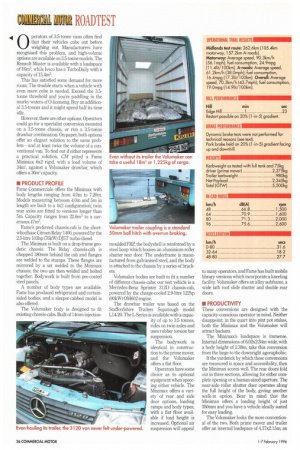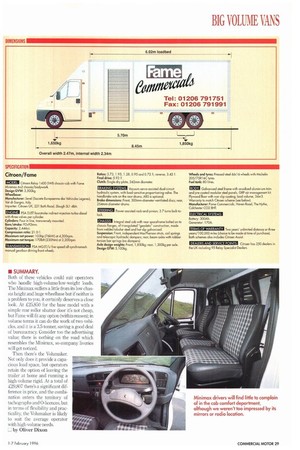O perators of 3.5-tonne vans often find that their vehicles cube
Page 28

Page 29

Page 30

Page 31

If you've noticed an error in this article please click here to report it so we can fix it.
out before weighing out. Manufacturers have recognised this problem, and high-volume options are available on 3.5-tonne models. The Renault Master is available with a loadspace of 16m, while Iveco has a TurboDaily with a capacity of 15.4m3.
This has satisfied some demand for more room; The trouble starts when a vehicle with even more cube is needed. Exceed the 3,5tonne threshold and you're paddling in the murky waters of 0-licensing. Buy an additional 3.5-tonner and it might spend half its time idle,
However, there are other options. Operators could go for a specialist conversion mounted on a 3.5-tonne chassis, or run a 3.5-tonne drawbar combination. On paper, both options offer an elegant solution to the same problem—and at least twice the volume of a conventional van. To find out if either represents a practical solution, CM pitted a Fame Minimax 6x2 rigid, with a load volume of 34e, against a Volumaker drawbar, which offers a 36m' capacity.
• PRODUCT PROFILE
Fame Commercials offers the Minimax with body lengths ranging from 4.0m to 7.20m. Models measuring between 4.0m and 5m in length are built to a 412 configuration; twin rear axles are fitted to versions longer than 5m. Capacity ranges from 22.6m3 to a cavernous 47m3.
Fame's preferred chassis-cab is the shortwheelbase Citroen Relay 1400, powered by the 2.5-litre 103hp (76kW) DJ5T turbo-diesel.
The Minimax is built on a drop-frame geodetic chassis. The Relay chassis-cab is chopped 180mm behind the cab and flanges are welded to the stumps. These flanges are mirrored by a set welded to the Minimax chassis; the two are then welded and bolted together. Bodywork is built from pre-coated steel panels.
A number of body types are available. Fame has produced refrigerated and curtainsided bodies, and a sleeper-cabbed model is also offered.
The Volumaker body is designed to fit existing chassis-cabs. Built of 14mm injection. moulded FRP, the bodyshell is reinforced by a steel hoop which houses an aluminium roller shutter rear door. The underframe is manufactured from galvanised steel, and the body is attached to the chassis by a series of brackets.
Volumaker bodies are built to fit a number of different chassis-cabs; our test vehicle is a Mercedes-Benz Sprinter 312D chassis-cab, powered by the charge-cooled 2.9-litre 122hp (90kW) 0M602 engine.
The drawbar trailer was based on the Stffordshire Trailers Supatough model L14/20. The L-Series is available with a capacity of up to 3.5 tonnes, rides on twin axles and uses rubber torsion bar suspension.
The bodywork is identical in construction to the prime mover, and the Volumaker offers a flat floor.
Operators have some choice as to optional equipment when speccing either vehicle. The Minimax offers a variety of rear and side door options, loading ramps and body types, with a flat floor available if load height is increased. Optional air suspension will appeal
to many operators, and Fame has built mobile library versions which incorporate a kneeling facility Volumaker offers an alloy subframe, a wide lath roof slide shutter and double rear doors
• PRODUCTIVITY These conversions are designed with the capacity-conscious operator in mind. Neither disappoint; in the quart into pint pot stakes, both the Minimax and the Volumaker will attract backers.
The Minimax's loadspace is immense. Internal dimensions of 6.02x2.34m wide, with a body height of 2.38m, take this conversion from the large to the downright agoraphobic.
If the yardstick by which these conversions are measured is space and accessibility then the Minimax scores well. The rear doors fold out in three sections, allowing for either complete opening or a human-sized aperture. The near-side roller shutter door operates along the full height of the body, giving another walk-in option. Bear in mind that the Minimax offers a loading height of just 350mm and you have a vehicle ideally suited for easy loading.
The Volumaker looks the more conventional of the two. Both prime mover and trailer offer an internal loadspace of 4.17x2.15m; an internal height of 2.17m is tall enough to stand up in, while the loading height of 650mni is not high enough to be a problem.
The 1.53m gap between the prime mover and the trailer allows for plenty of loading space without uncoupling. However, the Volumaker combination is on the lengthy side; at 12.04m the potential exists for fun and games in crowded High Streets, Both the Volumaker and the Minimax offer good load restraint with wooden rails running the length of the loadspace—both conversions give operators a fair amount of latitude in speccing restraints. This is an important point, as the Minimax in particular is likely to find a home with operators involved in specialist load movements.
The price you pay for added volume is a lower payload: the Fame Minimax can carry 1,225k,g, compared with the Relay 1800 LWB's 1,575kg. But the Minimax can be plated at up to five tonnes GVW, increasing payload dramatically With the Volumaker, the payload of 1,225kg for the 3.5t GVW prime mover alone
1 compares with the 1,355kg available with the high-volume 312D Sprinter. The trailer adds another 1,020kg of payload.
Both vehicles have benefited from aerodynamic styling. The Minimax is supplied with air management fairings on the top and side of the body. The Volumaker has both a streamlined Luton section on the prime mover and a similarly designed trailer bulkhead. Both vehicles are fitted with side skirts.
Our Minimax was far from run-in, with just 463 miles on the clock. The Volumaker, at a little over 5,000 miles, was also in the settlingdown stage. This means that our fuel consumption figures can only be taken as provisional results. Fully laden, on the motorway section of our Midlands test route the Minimax returned 17.9mpg (15.81it/100km), compared with the Volumaker's 24.9mpg (11.41it/100km). The A-road section reversed the order, with the Fame managing 25.1mpg (11.314/100km), against the Volumaker's 16.4mpg (17.3litilOOkm), For the record, as 3.5-tonne GVW panel vans, a laden Sprinter 312D returned 29.0mpg (9.72litIOOkiM in a CM roadtest, compared with the Citroen Relay 1800LWB's 24.3mpg (11.11it/100km). It should also be noted that the Sprinter with its trailer was restricted to 60mph on the motorway.
• ON THE ROAD The Minimax benefits from Citroen's lively DJ5T engine, which is sprightly enough to hold 70mph on the motorway. Whether you'd want to run at this speed is a different matter-the sheer size of the Minimax body can cause handling problems and unexpected gusts result in a sweaty brow.
The Minimax's body height gives a very low centre of gravity. Coupled with the predictabilits,., of front-wheel drive, corners can be taken with verve: strangely enough the Minimax is happier on bends than in a straight line.
The sheer length of the Minimax, coupled with the wide track of the rear axles means that positioning is an acquired skill. With a wheelbase of 5.7m, the Minimax is not the most manoeuvrable vehicle in its class and power-assisted steering is not a luxury. Ventilated front discs provide comfortable and progressive braking. The handbrake was effective enough to hold the Minimax steady on the 1-in-5 test hill.
The five-speed manual gearbox is conventional, except for the dash-mounted stick which operates via cables, and is a delight to use. Removing the gearstick from the floor gives reasonable space for three people.
The gear ratios are reasonably spaced, and our 0-80km/h acceleration times averaged out at 222 seconds. The Minimax rattled up the 16% test hill in imin 17sec, reflecting the amount of useable power.
Our test Minimax is let down by chassis height, however. After a couple of days of driving we got used to the sound of the exhaust pipe grating along uneven road surfaces. But this was a hastily-built demonstration model, and production models should give around 40mm more clearance.
The Volumaker-bodied Sprinter combination is a less daunting drive. On the motorway stray gusts tempt the trailer off-course, but the overall feeling is one of confidence. Again, this is not a vehicle which needs to be driven fiat-out; keep something in reserve and handling problems like snaking will be reduced to a minimum.
The drawbar design gives the Volumaker better manoeuvrability than the Minimax. The trailer behaves predictably and corners well.
Our timed acceleration tests showed the Volumaker to be surprisingly nippy. Despite the braking effect caused by the trailer, it averaged 31.6sec on our 080kin/h test. Despite having to drop right down the box, a time of lmin 23sec was recorded for the test hill, which is far from poor. Braking is positive and assured, and the handbrake held on the 1-in-5 test hill. We did not perform dynamic brake tests due to the trailer's load of loose sandbags.
• CAB COMFORT Both cabs fall into the functional rather than the luxury class. The Relay is, by a small margin, the noisier of the two, but both provide a reasonable working environment.
Dash layout in the Sprinter is excellent; less so the Relay, where the lack of rev counter is a notable omission. Safety would be improved in the Relay cab by mounting the radio within arm's reach of the driver.
We were not impressed with the mirrors on the Minimax; a vehicle of these dimensions takes some reversing, and a bigger lens with a wider angle would be welcome. The Volumaker drawbar needs a split mirror as blind spots are inevitable when cornering.
Stowage space and seating is reasonable in both cabs. Both cabs have doors which open out fully and build quality is generally good. Overall, neither vehicle is of a standard which would make you rush to work in the morning, but neither is so uncomfortable as to make you take a day off. • SUMMARY.
Both of these vehicles could suit operators who handle high-volume/low-weight loads. The Minimax suffers a little from its low chassis height and huge wheelbase but if neither is a problem to you, it certainly deserves a close look. At £25,850 for the base model with a simple rear roller shutter door its not cheap, but Fame will fit any option (within reason); in volume terms it can do the work of two vehicles, and it is a 3.5-tonner, saving a good deal of bureaucracy. Consider too the advertising value; there is nothing on the road which resembles the Minimax, so company liveries will get noticed.
Then there's the Volurnaker. Not only does it provide a capacious load space, but operators retain the option of leaving the trailer at home and running a high-volume rigid. At a total of £29,807 there's a significant difference in price, and the combination enters the territory of tachographs and 0-licences, but in terms of flexibility and practicality. the Volurnaker is likely to suit the average operator with high-volume needs.
by Oliver Dixon
































































































